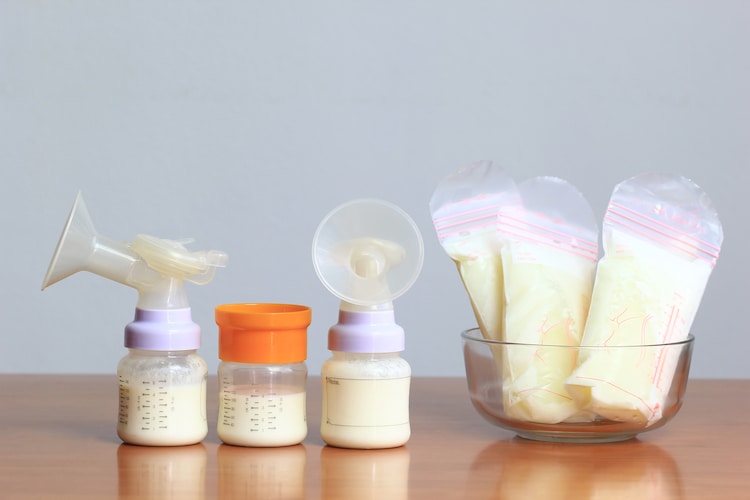Is pumped milk as nutritious for your baby as direct breastfeeding?
While pumping is becoming increasingly popular among breastfeeding moms, many are still hesitant in choosing this method. Find out from the experts if pumped milk is just as good.
in short
- Pumped and breastfed milk contain the same essential nutrients
- Direct feeding is often preferred because it provides skin-to-skin contact.
- However, pumped milk is a flexible and convenient option
Times have certainly changed when it comes to parenting. Although our parents raised us in simple ways (and did a pretty good job), today’s parents are more aware of what their newborns need and are careful about the choices they make. Live.
From choosing toxin-free products to keeping young children away from added sugars and even starting their education early, parenting practices have seen significant upgrades.
Breastfeeding has also become compatible with modern life. Many mothers now use breast pumps to store milk, so that their babies can get good nutrition even when they are not around. This has been especially helpful for working moms and moms who travel frequently, allowing them to balance work and parenting while still meeting the needs of their children.
But is pumped milk as good?
Pumped Milk vs Breastfed Milk
Dr Sandhya Rani, Senior Consultant, Obstetrics and Gynaecology, Aster Women and Children’s Hospital, Bengaluru, tells India Today Although the basic nutritional value of both pumped and breastfed milk is the same, there are some subtle differences.
- Direct breastfeeding makes it easier to adapt the milk to the baby’s needs, as many hormones are released during the process and this helps to enhance the nutritional and immune properties of the milk in real time.
- Additionally, breast milk has been found to be optimally distributed with fat at each stage of the breastfeeding session, a feature that may be difficult to recreate with pumped milk.
- Bottled breast milk, or pumped milk, retains all the vital nutrients, fats and immune factors and can be a good alternative where breastfeeding is not possible.
- However, some nutrients may be slightly depleted due to storage, especially if the milk is stored in the freezer for longer than the recommended period.
Dr. Nirmala Chandrasekhar, Senior Consultant, Obstetrics & Gynaecology, Gleneagles BGS Hospital, Bengaluru, also mentions that the key to preserving the nutritional value of pumped milk is to ensure that it is stored correctly in clean containers. It should be prepared and kept at proper temperature in the refrigerator.
She adds, “As long as these guidelines are followed, pumped milk retains the same nutrients as fresh breast milk, including proteins, fats, vitamins and antibodies.”
Meanwhile, Dr. Apoorva Gupta, Consultant, Obstetrics & Gynecology, Daffodils by Artemis, Delhi, shares that direct feeding is often considered ideal as it allows skin-to-skin contact, which promotes bonding between the baby and the baby. Can increase and control its temperature. Additionally, the baby’s sucking response can stimulate milk production.
However, pumped milk is a viable option that offers flexibility and allows others to help feed the baby, which can be especially beneficial for working mothers or mothers with specific medical conditions.

understanding the pros and cons
pumped milk
- Pumped milk provides flexibility, allowing others to feed the baby and enabling mothers to return to work or take time for themselves.
- This method ensures that the baby is given milk in measured quantities.
- This is convenient for storing milk for future use, ensuring that milk is available when direct feeding is not possible.
- Expressing milk can provide relief from swollen breasts and allow the body to continue producing milk even when the baby is not directly breastfeeding.
- However, some nutrients and immune components may lose effectiveness over time, especially when stored frozen.
- Pumping, clearing, and storing milk requires additional time and specialized equipment, which can be challenging and expensive for some parents.
- Pumping does not completely mimic a baby’s feeding patterns, which can sometimes reduce the nutritional content over time.
breast milk
- Direct feeding provides many nutritional benefits. The composition of breast milk naturally changes to meet the baby’s needs, whether they are healthy or unhealthy.
- Direct breastfeeding strengthens the bond between mother and child.
- Breastfeeding is easily accessible, requires no preparation, and costs nothing.
- Exclusively breastfed babies often have a lower risk of conditions like allergies, asthma, obesity and infections.
- However, breastfeeding can be challenging, as it depends entirely on the mother, limiting mobility.
- The mother may also need to pay attention to her diet to avoid foods that may bother the baby.
- Some mothers may experience discomfort, such as sore nipples or breast enlargement.
correct way to pump
Dr. Sandhya Rani advises that to safely pump and store breast milk, it is essential to clean your hands properly and use clean, sterilized parts and containers. Using the pump in a quiet, relaxing environment can help make milk flow easier. Additionally, storing milk in smaller quantities can also help reduce wastage.
Dr. Nirmala Chandrasekhar explains that the correct method of pumping breast milk involves using a mechanical or electric pump that creates a vacuum, intermittently suctioning and releasing.
It is important to label the milk with the date and time it was expressed and to bring it to room temperature before feeding.
How to store:
- Room temperature (up to 77°F or 25°C): Freshly expressed milk can be stored for up to 4 hours.
- Refrigeration (at 40°F or 4°C): Milk can be kept in the refrigerator for 4 days.
- Freezer (0°F or -18°C or lower): Frozen breast milk can be stored for 6-12 months, although it is best to use it within 6 months to preserve the nutrients.

What about frozen milk?
Experts suggest defrosting frozen milk in the refrigerator overnight or placing the sealed container in a bowl of warm water until the milk warms. Avoid heating breast milk, especially in the microwave, as this may ruin some of the nutrients. After heating, swirl the milk slowly so that the fat rising on the surface gets mixed in.
How to choose?
Dr. Apoorva Gupta says that in India, there is a cultural taboo around pumped milk, but it is important to educate people about the benefits of both breastfeeding and pumping.
Additionally, Dr. Sandhya Rani says, “Some people believe that breastfeeding is the only natural way to feed a baby and consider bottle-fed breast milk to be less healthy. Removing this stigma can help mothers Is.”
For many people, direct breastfeeding is often the first choice because of its natural benefits, including ease of attachment and transfer of nutrients. However, pumping can be a valuable alternative if direct breastfeeding is not possible.
Choosing to pump or breastfeed depends on the mother’s lifestyle, health, and personal goals. For working moms or moms with busy schedules, pumping can be a practical way to provide breast milk when they don’t have milk available. This also allows other caregivers to share in the meal, creating opportunities for additional bonding.
Mothers should prioritize their own comfort and their baby’s needs, choosing a method that best suits their situation. While pumping requires time and equipment, choosing between pumping and direct breastfeeding is a personal decision based on each mother’s comfort and preferences.







